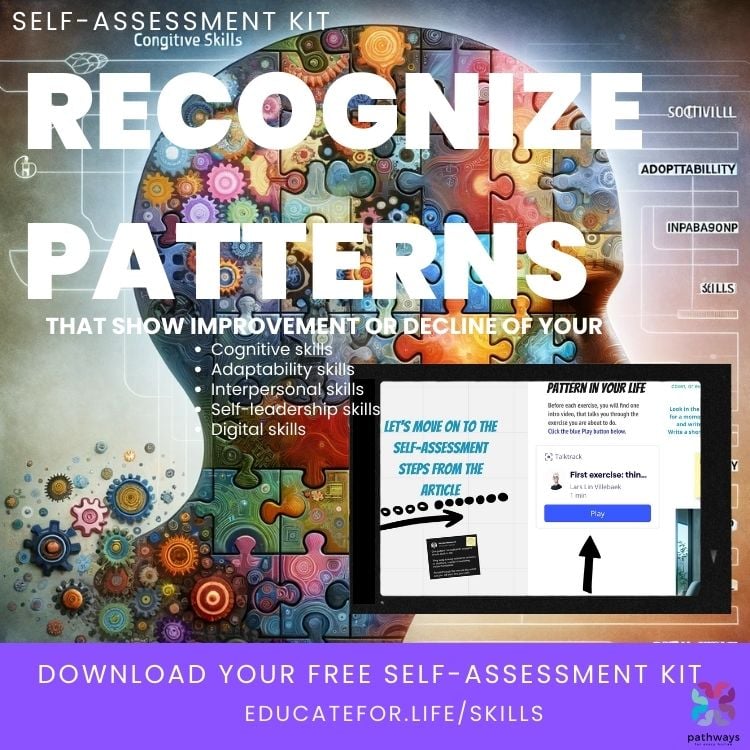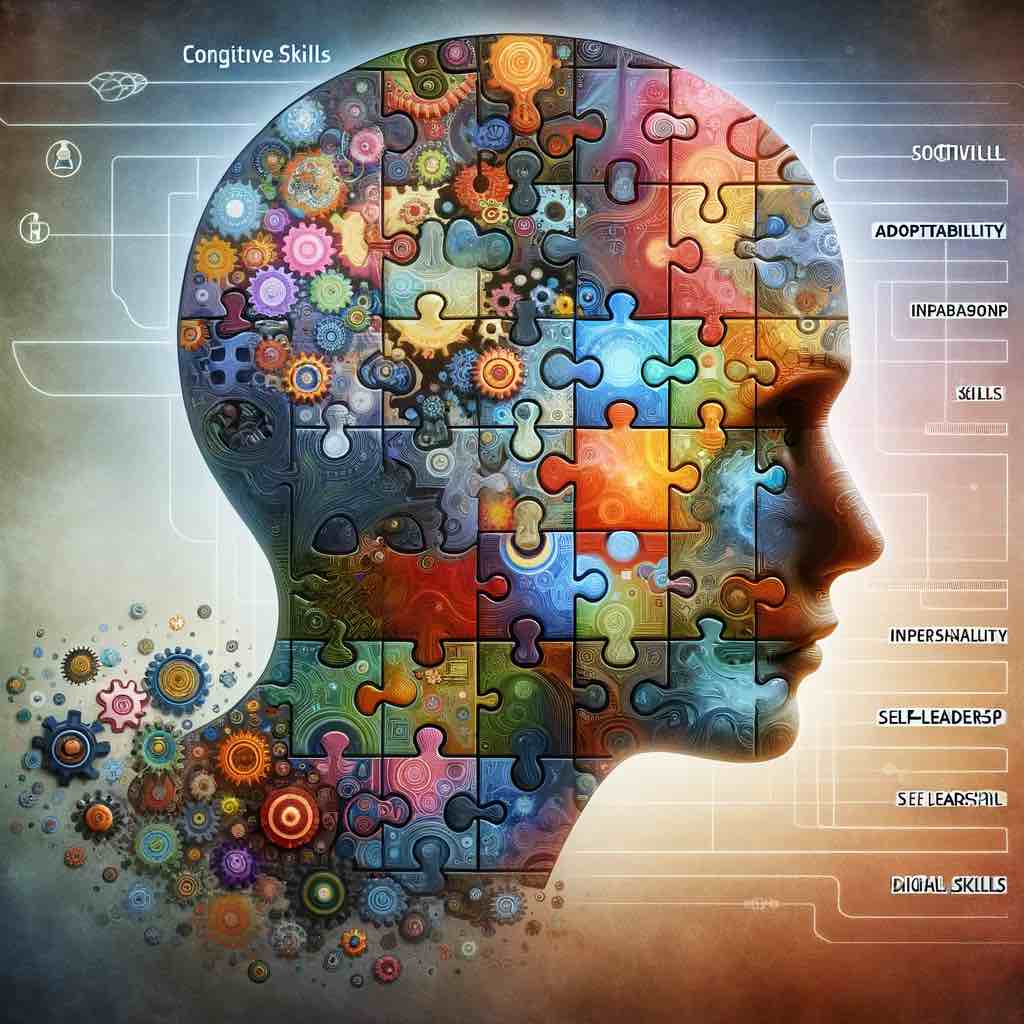Your Human Power of Pattern Recognition: A Key Skill for Accomplishing Your Desired Results
Introduction:
Research shows that people who leverage their primary talents every day are: 6 times more likely to be fully engaged in their work, 6 times more likely to feel that they can perform their best every day, and 3 times more likely to experience an excellent quality of life.
What are your primary talents, and are you leveraging them every day? If not, why not?
A while back, I took a Talent Discovery profiling. Based on 50 cognitive studies on over 1.2 million individuals, the assessment identifies our unique combination of 34 universal talents. One of my most featured talents, according to this profiling, is Strategy.
My profile says: “You have a distinct way of thinking, and you always look at things from a strategic point of view. This perspective allows you to see patterns, play out scenarios, predict potential obstacles, and draw out the best plan to get to your destination.”
You know what… this is a very accurate description of many of the innovation- & transformation processes I have been leading and facilitating for corporations and other organizations worldwide that past (many) years. No wonder I enjoy it.
In a world that's rapidly evolving, our ability to recognize patterns stands out as a crucial skill for success. Tony Robbins, a renowned life coach and motivational speaker, has emphasized the importance of three skills:
- Recognizing patterns
- Using patterns, and
- Creating new patterns (habits).
This article puts the spotlight on the first of the three, Recognizing Patterns.
This focus on pattern recognition isn't just about understanding trends in data; it's about perceiving the underlying structures in various aspects of life - be it in business, personal relationships, and for sure, our own behaviors. Recognizing patterns enables us to predict outcomes, make better decisions, and adapt more effectively to change.
So what might these patterns look like? Let me give you a few patterns I very often hear people describe very detailed from their own life:
- Feeling overwhelmed
- stressed
- does not take needed actions
Do you recognise any of these patterns from your own life?
Definitions:
Let's take a step back and unbox two important definitions:
Signals:
Signals manifest when there is a change in the behaviour or attitude of people, or in your environment.
Examples of signals that are important to be aware of are:
- Social Signals:
- Example: A sudden shift in public opinion or behavior, like an increase in remote working or homeschooling, can signal a change in social dynamics. The rise of social media movements and trends, such as #MeToo, reflects changing attitudes towards gender equality and social justice.
- Technological Signals:
- Example: The emergence of a disruptive technology, like artificial intelligence (AI) or blockchain, signals a shift in the technological landscape. The rapid development and adoption of electric vehicles signal a transformation in the automotive industry and consumer preferences.
- Economic Signals:
- Example: Fluctuations in stock markets or sudden changes in unemployment rates can signal economic shifts. The increasing prevalence of the gig economy, with more people engaging in freelance work, signals changes in traditional employment models.
- Environmental Signals:
- Example: Observable changes in climate patterns, such as more frequent and severe weather events, signal environmental shifts. The bleaching of coral reefs is a signal of changing ocean conditions and broader environmental issues like global warming.
- Political Signals:
- Example: A sudden policy change or the election of a government with a radically different agenda can be a signal of political change. The rise of populist movements in various countries signals a shift in political attitudes and possibly dissatisfaction with the status quo.
In each of these categories, the signals represent indicators of change, often requiring interpretation and analysis to understand their broader implications and potential future impacts.
Patterns:
Patterns are the repetition of signals.
It can be identified when people repeat behaviours, attitudes, and preferences. To spot them, it means to “connect the dots” towards, finding patterns will lead you to identify potential future opportunities for developing your skills and mindset as well as identify undesired habits or beliefs that you will decide to unlearn.
Analyze patterns: Common patterns for most people are found in time-wasting activities, such as excessive email or social media use. Sleeping patterns and patterns in your mood are common for many too.
Identifying patterns in one's behavior or habits that may indicate a lack of personal development is crucial for self-awareness and growth. Here are some common patterns that might suggest stagnation in personal development:
- Resistance to Change:
- Consistently avoiding new experiences, changes in routines, or refusing to learn new skills. This resistance can limit exposure to new ideas and experiences necessary for growth.
- Procrastination:
- Regularly putting off tasks and responsibilities. This habit can indicate a lack of motivation or fear of failure, hindering progress and achievement.
- Lack of Goal Setting:
- Not setting or striving towards personal or professional goals. This might suggest a lack of ambition or direction, which is essential for personal development.
- Avoiding Challenges:
- Shying away from tasks or situations that are perceived as challenging, preferring to stay in the comfort zone. This avoidance can prevent the development of new skills and resilience.
- Negative Self-Talk:
- Frequently engaging in self-criticism or negative thoughts about oneself. This pattern can lead to reduced self-esteem and hinder self-improvement efforts.
- Failure to Reflect:
- Not spending time reflecting on past experiences, both successes and failures. Lack of reflection can lead to repeated mistakes and missed opportunities for learning.
- Constant Comparison with Others:
- Regularly comparing oneself to others in a way that leads to feelings of inadequacy or jealousy, rather than as a source of inspiration or learning.
- Lack of Self-Care:
- Neglecting physical, mental, or emotional well-being, which is crucial for overall personal growth and development.
- Inability to Accept Feedback:
- Consistently getting defensive or upset when receiving constructive criticism. This can indicate a lack of openness to learning and self-improvement.
- Stagnant Social Interactions:
- Not expanding social circles or engaging in diverse social interactions. Limited exposure to different perspectives can hinder personal growth.
Identifying and acknowledging these patterns is the first step towards personal development. Once recognized, one can work on breaking these habits, setting realistic goals, seeking new experiences, and embracing a mindset of continuous learning and self-improvement.
The Significance of Recognizing Patterns:
ONE OF THE WEIRDEST THINGS ABOUT HUMAN BEINGS IS how we get so used to limited options without questioning them -AND HOW WE TEND TO REPEAT AND BE STUCK IN UNDESIRED or UNRECOGNIZED PATTERNS without questioning them..
Recognizing patterns is a skill that serves as a foundation for critical thinking and problem-solving. It helps us navigate through complex information, discern connections, and anticipate future trends. In the professional realm, whether you're an entrepreneur predicting market trends, a programmer debugging code, or a marketer understanding consumer behavior, recognizing patterns is indispensable.
One type of patterns we often underestimate or ignore are our own communication patterns.
What is a recurring pattern of communication that always put you in an argument, or that you keep using but it never leads to the results you were hoping for? Do you see such a pattern in your own life? Have you ever questioned why you keep staying in this pattern? Would you want to change the pattern? What would it take to begin the change?
Do you have examples in your life of communication patterns you would benefit from changing? For some it is to get better at asking for help, be clear and specific when asking others for something, or simply communicate more actively (or perhaps become an active listener is what is next?).
Patterns can predict the improvement or decline of your skills.
Patterns, once you have identified them, are important predictors for skills that are currently either improving or in decline.
Your Self-assessment:
HEY, before you move on to explore the details of how to self-assess your own pattern recognition skills, why don't we send you our free Miro board with all the self-assessment exercises, video guided and everything? Click the button right below here if you want to receive it by email:
Let's exemplify patterns that can predict improvement or decline of your skills.
In each of the following skills areas: are you mostly seeing IMPROVEMENT PATTERNS or DECLINE PATTERNS?Make your notes for yourself as you go through this list:
- Cognitive Skills:
- Improvement Pattern: Regular engagement in problem-solving activities, active participation in debates, and continuous learning can lead to enhanced critical thinking and logical reasoning skills.
- Decline Pattern: Lack of intellectual challenges, reliance on biased information sources, and avoiding analytical tasks can lead to a decline in cognitive abilities.
- Adaptability Skills:
- Improvement Pattern: Individuals who actively seek new experiences, are open to change, and regularly step out of their comfort zones are likely to develop stronger adaptability skills.
- Decline Pattern: Resistance to change, sticking to familiar routines, and avoiding new challenges can lead to a decrease in adaptability.
- Interpersonal Skills:
- Improvement Pattern: Consistent efforts in empathetic listening, engaging in diverse social interactions, and actively building relationships can enhance interpersonal skills.
- Decline Pattern: Isolation, lack of social interactions, and avoidance of teamwork can lead to weakened interpersonal skills.
- Self-leadership Skills:
- Improvement Pattern: Setting personal goals, self-reflection, and actively seeking feedback can improve self-awareness, integrity, and self-motivation.
- Decline Pattern: Lack of self-reflection, avoidance of responsibility, and ignoring personal development can result in a decline in self-leadership skills.
- Digital Skills:
- Improvement Pattern: Regularly updating digital knowledge, experimenting with new technologies, and engaging in digital learning platforms can enhance digital fluency.
- Decline Pattern: Avoiding the use of technology, reluctance to learn new digital skills, and ignoring digital advancements can lead to a decline in digital competencies.
These patterns are predictive in nature, indicating how consistent behaviors and attitudes can lead to either the improvement or decline of these essential human skills. In this age of rapid technological advancement and accelerating pace of change in the workforce globally, you will want your skills to improve, I guess.
The capacity to link disparate pieces of information reflects a sophisticated level of pattern recognition. It's about seeing the big picture and understanding how different elements interconnect. Thinking of improving your AI Literacy (read about that here), then you will find yourself in a domain dominated by advanced pattern recognition.
Cultivating the Skill of Recognizing Patterns:
When it’s time to focus your personal skill development on the skill of Recognizing Patterns, here are some activities you can easily explore and try out, regardless of your ambition level:
- Mindful Observation:
- Start by being more observant of your surroundings. Pay attention to details and try to notice trends and repetitions in everyday life.
- Reflective Journaling:
- Keep a journal to reflect on your day-to-day experiences. Over time, this can help you identify patterns in your behavior, decisions, and their outcomes.
- Diversify Your Experiences:
- Expose yourself to different environments, cultures, and fields of knowledge. This broadens your perspective and enhances your ability to recognize diverse patterns.
- Engage in Puzzles and Brain Games:
- Activities like puzzles, chess, and strategic games stimulate your brain and hone your pattern recognition skills.
- Seek Feedback:
- Regularly seek feedback from peers and mentors. They can offer insights into patterns you might have overlooked. Visit the EducateforLife Pathways program to learn more about how you can get coaching and an in-depth skill-development focused on Recognizing Patterns or any of the other skills that are offered through the program.
Now it’s your turn:
Have a look in this “MindMirror”. What patterns do you observe in yourself?

- Note down all your observations in a reflective process, that only gets better if you keep returning to it over some days. Place each of your observations in one of the following three grounding inquiries:
- Patterns to lean into (challenges): What feels hard and important to lean into?
- Patterns to draw on (resources, strengths): What will support you in leaning into challenge?
- Patterns to activate with others: What feels critical to hold at center in your collaboration with others?
Through individual reflection and group exploration, this process will help you focus your energies and intentions as you transition into whatever comes next.
The more we unlearn rigid thinking patterns, the better we become at Recognizing Patterns. Read more about how to Unlearn in The Paradox of Expertise: Why Unlearning Is the New Skill You Need** here
🥳 Congrats
You completed the introduction round of improving your Pattern Recognition skills.
We know that navigating the fast paced changes in our world takes well developed Pattern Recognition skills, both when it comes to our individiual human patterns, but also at business level and societal level.
Ask for our FREE Miro board with the self-assessment exercises that helps you identify the most positive and negative recurring patterns that control you and your life right now. This is an effective way to sharpen your Pattern Recognition skills -and unlearn the patterns you no longer find desirable to stick with. Click here to request this self-assessment kit (for free).

Visit also the rest of the most important 60 Human Skills in a #Tech World.
